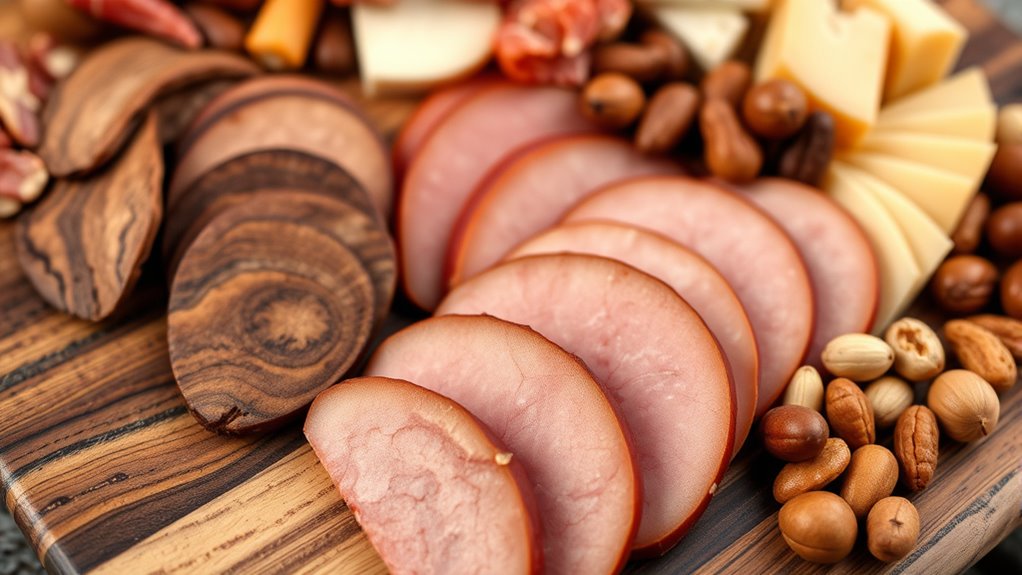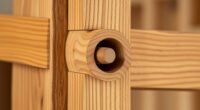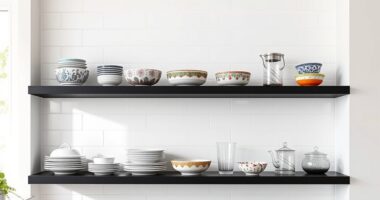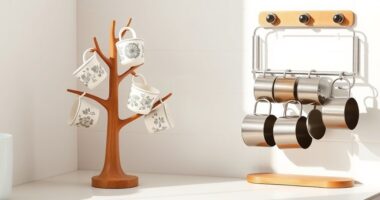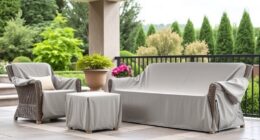When choosing the best wood species for charcuterie boards, prioritize durability, safety, and appearance. Hardwoods like maple, walnut, and cherry resist dents, stains, and moisture, making them ideal options. Maple offers a smooth, tight grain, while walnut and cherry add rich, unique patterns. Eco-friendly options like bamboo or reclaimed wood can also work well. Balancing aesthetics and practicality guarantees your board will last and look stunning—exploring these options further will help you find the perfect fit.
Key Takeaways
- Prioritize hardwoods like maple, walnut, and cherry for durability, resistance to dents, and food safety.
- Consider grain patterns: tight, consistent grains for sleek looks; swirling grains for rustic charm.
- Choose eco-friendly options such as bamboo or reclaimed wood to support sustainability.
- Ensure the wood is easy to clean, stain-resistant, and maintains its appearance over time.
- Balance aesthetics with practicality by selecting woods that age well and require minimal maintenance.
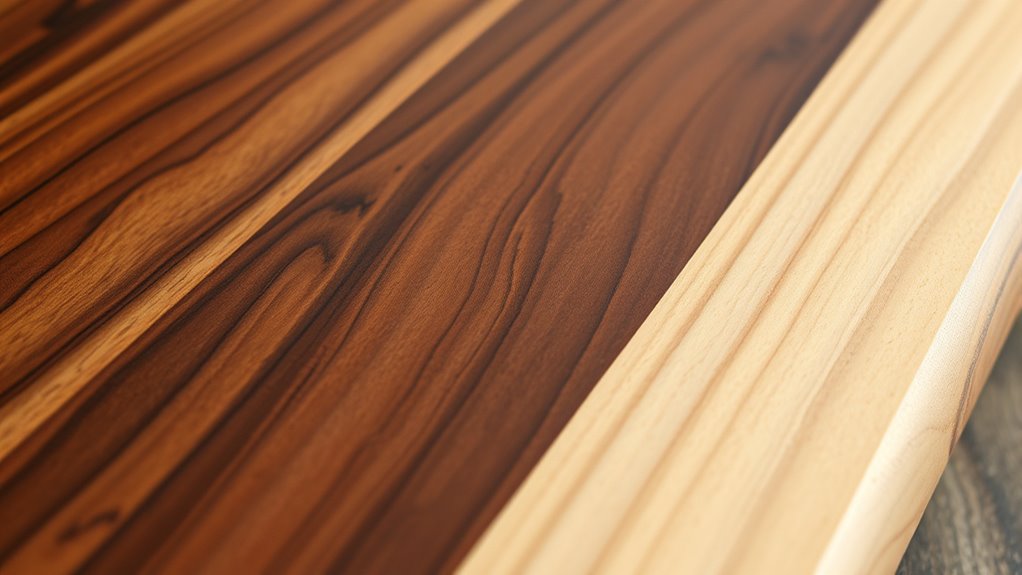
When selecting a wood species for your charcuterie board, it’s important to take into account durability, appearance, and food safety. The wood grain patterns play a significant role in the overall look, giving your board a unique character and aesthetic appeal. Some woods feature tight, consistent grain patterns that create a sleek, modern look, while others showcase more intricate, swirling grains that add rustic charm. Your choice of grain pattern influences not just the visual appeal but also how the wood ages over time. For instance, highly figured woods may develop a beautiful patina, enhancing their character, but they can also be more prone to scratches. On the other hand, smoother grain woods tend to be more resistant to staining and easier to clean, making them practical options for food prep surfaces.
In addition to appearance, you should consider eco friendly wood options that prioritize sustainability. As you browse, you’ll find that some woods are harvested responsibly, reducing environmental impact. Bamboo is a prime example of an eco friendly wood option — it’s technically a grass but functions as a durable, sustainable material often used for kitchenware. Reclaimed wood is another excellent choice, transforming old, discarded pieces into functional art. Choosing these options not only supports environmental conservation but also ensures your board is free from harmful chemicals often found in treated or synthetically finished woods.
Furthermore, understanding production quantity variance can be helpful when evaluating the costs associated with sourcing different wood types for your project, ensuring you stay within budget. Durability is equally important, especially since your charcuterie board will see frequent use. Hardwoods like maple, walnut, and cherry are excellent choices because they resist dents and scratches better than softer woods. Maple, in particular, is popular for its tight grain and smooth finish, making it both durable and food-safe. Walnut offers a rich, dark appearance with striking grain patterns, adding a touch of elegance without sacrificing resilience. Cherry wood is slightly softer but still sturdy enough for regular use, and it develops a beautiful reddish hue over time. When selecting a wood species, consider how well it stands up to moisture and knife marks, as these factors will impact the longevity of your board.
Ultimately, the right wood for your charcuterie board balances aesthetic appeal with practicality and eco consciousness. By paying attention to the wood grain patterns and opting for eco friendly options, you ensure your board is beautiful, sustainable, and safe for food preparation. This thoughtful approach results in a piece that’s not just functional but also a reflection of your values and style.
Frequently Asked Questions
How Do Different Wood Types Affect the Flavor of Foods?
Different wood types can influence your food’s flavor through wood flavor transfer, subtly adding unique tastes. Some woods have taste enhancement properties that can enrich the flavors of cheeses and meats, while others might impart unwanted tastes or odors. You should choose woods that complement your foods, avoiding those that could negatively affect flavor. Understanding these effects helps you select the right wood to enhance your charcuterie experience without compromising food quality.
Are There Eco-Friendly or Sustainable Wood Options for Charcuterie Boards?
Imagine you’re nurturing a tiny forest with every chop—eco-friendly options make this possible. You can choose woods from sustainable forestry practices, ensuring trees are replenished after harvest. Look for charcuterie boards finished with eco-friendly finishes, which protect without harming the environment. By selecting these options, you’re not just creating a beautiful board but also supporting a greener planet. Your choices make a difference, blending style, function, and sustainability seamlessly.
What Is the Typical Lifespan of a Wood Charcuterie Board?
Your wood charcuterie board typically lasts several years with proper wood preservation. Its lifespan depends on how often you clean and maintain it. To extend its longevity, follow simple longevity tips like avoiding soaking, regularly oiling the surface, and preventing deep cuts. Proper care helps preserve the wood’s natural beauty and prevents warping or cracking, ensuring you enjoy your board for many gatherings to come.
How Do I Properly Maintain and Clean Various Wood Species?
Did you know that properly maintained wood boards can last decades? To keep them in top shape, clean with warm water and mild soap, avoiding soaking. Use food-safe oils to nourish the wood grain patterns, preventing cracks and warping. Regularly reapply oil, especially after washing, to maintain their quality. Avoid harsh chemicals or dishwasher cleaning, as these can damage the wood’s surface and compromise its longevity.
Can Certain Woods Cause Allergic Reactions or Sensitivities?
You might wonder about wood allergy risks or sensitivities from woods, and yes, some people can have reactions. Certain woods like oak, walnut, or exotic species can cause sensitivities, leading to itching, rashes, or respiratory issues. To minimize risks, wash your hands after handling, avoid direct contact if you have known sensitivities, and consider using food-safe finishes. If you notice reactions, consult a healthcare professional for guidance.
Conclusion
Choosing the right wood species makes your charcuterie board both beautiful and durable. Did you know that maple and walnut are among the most popular choices because they resist bacteria and scratches? This means your board stays safer and looks great longer. So, pick a wood that suits your style and needs—your guests will love the presentation, and you’ll enjoy using it for years to come. Happy hosting!
